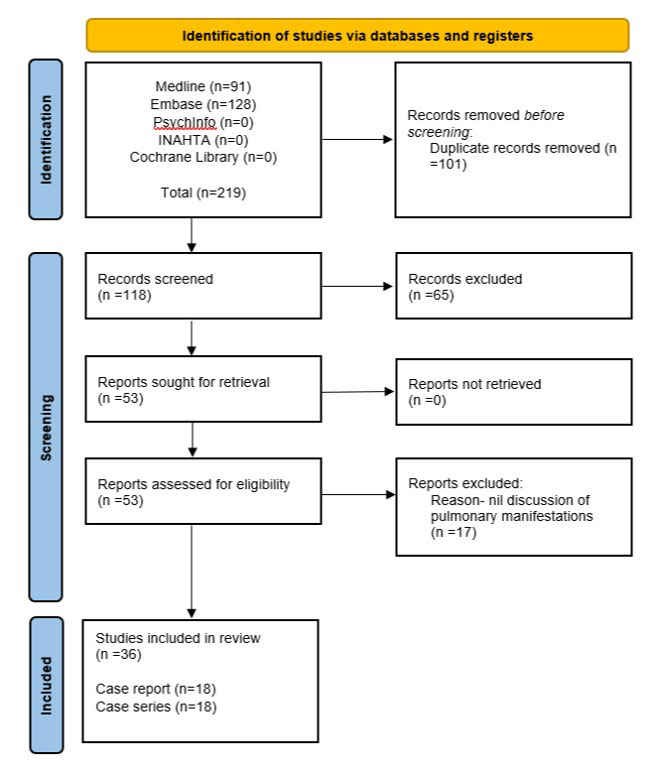Session Information
Session Type: Poster Session B
Session Time: 9:00AM-10:30AM
Background/Purpose: VEXAS (vacuoles, E1 enzyme, X-linked, auto-inflammatory, somatic) syndrome is a newly described auto-inflammatory disease, characterised by somatic mutation of UBA1 [1]. A consistent feature of many cases is pulmonary infiltrates, or respiratory failure.
This systematic review aimed to summarise the respiratory manifestations in VEXAS syndrome, described in the literature to date.
Methods: All published articles discussing VEXAS syndrome were included, until May 2022. Initial scoping reviews were performed to optimize the search strategy. Given the relative recency of VEXAS in the literature, the final search was kept deliberately broad to ensure all relevant papers were captured. Medline, Embase, International Network of Agencies for Health Technology Assessment, PsychInfo and Cochrane Databases were searched.
The research question was: What are the pulmonary manifestations in patients with VEXAS syndrome? The search was restricted to English-language articles and those discussing clinical presentation of disease. All article types were deemed eligible except opinion articles and reviews.
Titles and abstracts were screened. Articles meeting inclusion criteria were examined by one author, with 20% validity screening. In addition to basic demographics, information was extracted on type and prevalence of pulmonary manifestations, disease associations at first presentation of VEXAS, and, if mentioned, author conclusions on pulmonary involvement.
Results: Initially, 219 articles were retrieved with 36 ultimately included (18 case reports, 18 case series; Figure 1). A pooled total of 269 patients with VEXAS were included, 98.6% male, mean age 66.8 years (SD 7.3) at disease onset. Patients were from: Europe (n=181); North America (62); South America (n=1); Asia (n=21); Australasia (n=4).
56.1% had pulmonary involvement at presentation. The most frequently described pulmonary manifestation was infiltrates (43.1%; n=116), followed by pleural effusion (7.4%; n=20) and idiopathic interstitial pneumonia (3.3%; n=9). Other pulmonary manifestations were: nonspecific interstitial pneumonia (n=1), bronchiolitis obliterans (n=3), pulmonary vasculitis (n=6), bronchiectasis (n=1), alveolar haemorrhage (n=1), pulmonary embolism (n=4), bronchial stenosis (n=1), and alveolitis (n=1). With regards co-existing autoimmune diseases, pulmonary involvement was described in patients previously diagnosed with or meeting diagnostic criteria for: relapsing polychondritis, certain vasculitides, systemic lupus erythematosus, Sweet’s syndrome, Behcet’s disease. However, it was not reported which of these patients had particular pulmonary manifestations.
Conclusion: Pulmonary disease is common in patients with VEXAS, frequently described as pulmonary infiltrates. It is unclear if respiratory manifestations are part of the primary disease or a co-existing condition. Epidemiological and larger cohort analyses in VEXAS patients will aid further characterisation of pulmonary involvement and disease management.
References
1. Beck DB et al. Somatic Mutations in UBA1 and Severe Adult-Onset Autoinflammatory Disease. N Engl J Med. 2020 Dec 31.
INAHTA= International Network of Agencies for Health Technology Assessment. Cochrane Library encompasses library of: systematic reviews; systematic review protocols; controlled clinical trials.
To cite this abstract in AMA style:
Kouranloo K, Ashley A, Zhao S, Dey M. Pulmonary Manifestations in VEXAS (Vacuoles, E1 Enzyme, X-linked, Autoinflammatory, Somatic) Syndrome: A Systematic Literature Review [abstract]. Arthritis Rheumatol. 2022; 74 (suppl 9). https://acrabstracts.org/abstract/pulmonary-manifestations-in-vexas-vacuoles-e1-enzyme-x-linked-autoinflammatory-somatic-syndrome-a-systematic-literature-review/. Accessed .« Back to ACR Convergence 2022
ACR Meeting Abstracts - https://acrabstracts.org/abstract/pulmonary-manifestations-in-vexas-vacuoles-e1-enzyme-x-linked-autoinflammatory-somatic-syndrome-a-systematic-literature-review/

